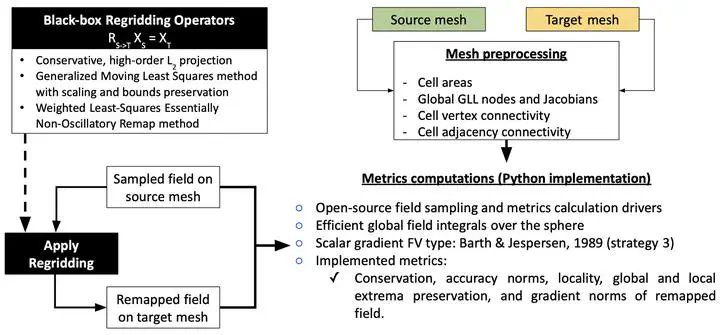Metrics for Intercomparison of Remapping Algorithms (MIRA) applied to Earth System Models
Abstract
Strongly coupled nonlinear phenomena such as those described by Earth System Models (ESM) are composed of multiple component models with independent mesh topologies and scalable numerical solvers. A common operation in ESM is to remap or interpolate results from one component’s computational mesh to another, e.g., from the atmosphere to the ocean, during the temporal integration of the coupled system. Several remapping schemes are currently in use or available for ESM. However, a unified approach to compare the properties of these different schemes has not been attempted previously. We present a rigorous methodology for the evaluation and intercomparison of remapping methods through an independently implemented suite of metrics that measure the ability of a method to adhere to constraints such as grid independence, monotonicity, global conservation, and local extrema or feature preservation. A comprehensive set of numerical evaluations are conducted based on a progression of scalar fields from idealized and smooth to more general climate data with strong discontinuities and strict bounds. We examine four remapping algorithms with distinct design approaches, namely ESMF Regrid, TempestRemap, Generalized Moving-Least-Squares (GMLS) with post-processing filters, and Weighted-Least-Squares Essentially Non-oscillatory Remap (WLS-ENOR) method. By repeated iterative application of the high-order remapping methods to the test fields, we verify the accuracy of each scheme in terms of their observed convergence order for smooth data and determine the bounded error propagation using the challenging, realistic field data on both uniform and regionally refined mesh cases. In addition to retaining high-order accuracy under idealized conditions, the methods also demonstrate robust remapping performance when dealing with non-smooth data. There is a failure to maintain monotonicity in the traditional $L^2$-minimization approaches used in ESMF and TempestRemap, in contrast to stable recovery through nonlinear filters used in both meshless (GMLS) and hybrid mesh-based (WLS-ENOR) schemes. Local feature preservation analysis indicates that high-order methods perform better than low-order dissipative schemes for all test cases. The behavior of these remappers remains consistent when applied on regionally refined meshes, indicating mesh invariant implementations. The MIRA intercomparison protocol proposed in this paper and the detailed comparison of the four algorithms demonstrate that the new schemes, namely GMLS and WLS-ENOR, are competitive compared to standard conservative minimization methods requiring computation of mesh intersections. The work presented in this paper provides a foundation that can be extended to include complex field definitions, realistic mesh topologies, and spectral element discretizations thereby allowing for a more complete analysis of production-ready remapping packages.
